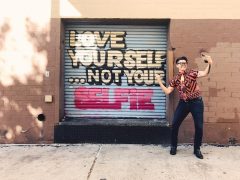Cover Story
VERONICA MAY: From the Psych Ward to the Stage
Introduction
When Veronica May was in high school, she thought she wanted to be a nun. In her mid-20s, she thought she was God. And not in a “wow, this woman is a musical god” kind of way (though she totally is, which I’m allowed to say as her friend and a human with ears); like, actual God. Father, Son, and Holy Ghost God. You see, Veronica May is an extraordinarily talented musician and she also has a diagnosis of Bipolar 1. Her new album, Awakened, is the beautiful, wrenching, hopeful expression of both of those parts of herself.
I’ll never forget the first time I saw Veronica May run her fingers along a piece of sandpaper attached to the body of her guitar. Looping that shh-shh-shh sound, she built layers and layers of acoustic elements I’ve never heard from a guitar: a tiny pinging sound from the strings right next to the tuning pegs, rhythmic percussive sounds made by rapping her palms and fingernails on the body, and singing into the hole of her guitar, creating a layered harmonic with multiple loops of her own voice. It’s just not everyday you see a human being turn a guitar into an actual convincing sounding train. It’s so exciting to watch and it consistently blows my mind that someone could even think to do those things, let alone do them so effortlessly as if that’s how guitars have always been played. As you would expect, that effortlessness is both innate and learned and she had the best teacher in her early years: her mom.
Life on the Farm
Veronica grew up on a farm in Colorado. And not just any farm: a musical one. When your mom studied piano under the first female conductor of the New York Philharmonic (Dr. Antonia Brico for you Jeopardy enthusiasts), your home is always alive with the sound of music:
“From the time I can remember my mom was behind the keys. When I think of her, I think of music. We have the biggest piano you can get and all through my life I’d crawl under the piano when she played. I would put my feet up on the underside of the piano and feel the vibration she created. Growing up, I learned piano as she taught from the kitchen. She had perfect pitch so if I played a wrong note she would yell, “That’s a G, not an F!” More than anything, mom gave me the gift of dynamics and touch. She plays the notes technically and with feeling.”
And you can hear exactly that when Veronica plays. When you listen to some of her music you can hear the farm and her family shaping its sound. Knowing this history about her greatly influences how you understand her songs, which bend to the more folk side of music. “My mom is an extension of my Grandmother’s music and I am an extension of hers. I play the same songs Grammie used to because my mother plays them. It’s a musical legacy I take seriously,” says Veronica.
From Mini Skirts to Bow Ties
You may also be surprised to know that in addition to growing up in a rural environment, Veronica was also her high school’s prom queen. I know. Our more masculine-presenting, lady-loving heroine used to be an avid mini-skirt and makeup wearer who dated boys (but she wants everyone to know she withheld all types of sexual contact from them. Gold star status all the way.). And while being a masculine-dressing lesbian doesn’t define all that Veronica is, it absolutely has relevance to some of the important work she’s doing as a musician. Writing and singing love songs about women when you yourself are a woman is, perhaps regrettably, still a pretty revolutionary act. Breaking down the hetero-normativity in love songs means something. Existing as a woman who loves to embrace both the masculine and feminine parts of herself in the way she presents to the world matters. A lot. Veronica tells it through an anecdote at her gym:
“People may look at me and treat me a bit differently according to who they think I am due to the way I physically present myself. I was in the locker room at my gym. My locker was next to an 85-year-oldish woman. We kept to ourselves and I finally said to her, “Did you have a good workout?” We proceeded to have a 30-minute conversation and as I left I had a thought: For all I know she could have had an idea in her head of who a woman dressed in a more masculine style could be. The most common assumption about women who look like me is that we are standoffish. Tough. Man haters. In turn, I was reminded not all elders have a closed mind. Every moment I am out in the world I have the opportunity to change someone’s mind. We all have that opportunity.”
From the Cloister to the Clinician
Throughout her life, Veronica has explored a variety of life paths. There was her previously mentioned desire to be a nun when she was in high school. She even visited the cloister and despite the fact that there were no women under 40, it still seemed like a great idea to her. Fortunately for all of us, that life path took a back seat to college where she had four majors (business, communication, technical journalism, and human development and family studies) before finding the fifth: music therapy.
We all have music therapy to thank for her presence in San Diego (thanks, music therapy!). After finishing her education she had to complete a six-month internship and was selected by Dr. Barbara Reuer of MusicWorx in San Diego. On receiving her acceptance letter, Veronica said, “Looking back I am amazed that I wasn’t more freaked out at the time. I knew no one in San Diego. I had never lived outside of Colorado. I had always had a roommate that took care of stuff like getting rent checks together, gas/electric, etc. What was the one thing I kept worrying about? Parallel parking.” Fortunately, 10 years later she’s a little less intimidated by parallel parking and has found a true home and community here.
So what is music therapy? It’s a therapeutic field that uses music to achieve non-musical goals. Veronica has worked with a wide variety of populations from children with autism spectrum disorders to adults with Alzheimer’s to people recovering from drug and alcohol addiction.
While working as a music therapist, she’s also been a musician on the side, most notably as a member of the duo the Lovebirds, with other side projects like the Forget Me Nots and the Lady Parts. Her years in the Lovebirds with bandmate Lindsay White brought her a variety of new experiences as a musician and performer: three full-length studio albums, several multi-state tours, Kerrville folk festival songwriting contest victory (2014), and the challenges and gifts that come with navigating a romantic breakup with your bandmate (in a duo, no less!) while figuring out how to move forward with your musical partnership:
“The Lovebirds brought me so much joy for over six years. It was a beautiful adventure and my bandmate, Lindsay White, was a big part of why it was a beautiful adventure. She stuck through it all with me, and our music unfolded before our eyes because we wrote about things we were experiencing together. Being in a band with someone who used to be your partner was not as challenging as it might sound on paper. Even though the band has dissolved, I know Lindsay always has my back and she is always there for me at my darkest moments. As the Lovebirds, we stayed true to our mission of Love.”
Simultaneously she’s been working on a book about her experiences with bipolar disorder and developing speaking engagements to talk about the subject in a variety of settings. But she started to recognize she was spreading herself too thin. “There’s a line in The Bell Jar where she’s sitting under a fig tree and all of them are ready to be picked and she didn’t know which one to pick so they all died. That need for focus is why I stopped being in the Lovebirds, quit working in music therapy, and mental health advocacy through books and speaking.” She’s focusing 100% of her energy on being a musician, saying, “I’ve never tried to be exclusively a musician. I have to try.” She also recognizes the role she can have as a musician with bipolar in achieving her goals of de-stigmatizing and advocating for people with mental health diagnoses through music.
Brief mental health education moment: there are two types of bipolar. Veronica’s diagnosis of Bipolar 1 means that in addition to the highs and lows that come with the diagnosis, her highs come with mania, which means she has hallucinations and delusions while someone with Bipolar 2 would have hypomanic symptoms that don’t include those psychotic symptoms. And like some other mental health diagnoses, it often hits in your 20s, which is why Veronica didn’t have her first manic episode until she was 25.
The Parking Lot
The cover of her album is mostly black, with the stark white line of a parking space cutting through the darkness. On the left, Veronica is lying down with her eyes closed. On the right, another Veronica is crouched down with a lit match illuminating the space above her counterpart’s head. It might help to know that the parking lot is the same one where she was found by paramedics on May 4, 2008, after running away from her then-partner at her house as she ascended into her first manic episode. It’s important to note that event caught her and her friends off-guard since no one knew she had a bipolar diagnosis prior to then. (Sidenote: When Veronica is manic she has a lot of delusions that she needs to kill herself, not because she is depressed, but because it is the way she will save everyone. Her delusions are also often tied to religious themes of heaven and hell). She describes that night:
I stood in the parking space and the parking stopper was near my head. I had to keep my eyes closed. I had to let go. Surrender. I was at such peace. I had to let go of everything. I fell straight back and let my head hit the parking stopper. I was in complete trust of everything. I felt nothing at all. Let go of everything. I wet my pants. Everything needed to be let go.
I had to keep my eyes closed or the evil was going to try and take my soul from my eyes. If I opened them, I would go to hell. I heard a heart monitor bouncing off the building wall in front of me. It was my heart. It was slowing down. Finally, I thought, I have lost all of my blood and I’m going to die. The heart monitor went flat. A long tone. I’m dead. I saw the light. I heard an ambulance park next to me. It’s heaven! The angels are coming to pick me up and drive me up into heaven. I heard men coming out of the ambulance. “Ma’am! Ma’am can you hear me?” Stay calm. They rubbed my sternum. I felt nothing. “Ma’am!” I was still. “She’s faking it.” They put me on a gurney. This is it. I made it. There were so many times in my life that I have feared going to hell. The day is here and I’m going to heaven. “Ma’am we are putting an IV in your arm.” Wait. They were trying to poison me. This isn’t the ride to heaven. It’s the ride to hell! I am terrified. I am devastated. My eternity is going to be spent in hell.
If it feels intense, that’s because it is. But in a way, it’s also just a normal part of life. And by that I mean that we have this idea about people with mental health diagnoses that stigmatizes them for having a medical condition in their brain instead of another part of their body. That stigma can build into fear which makes it harder to talk about mental health issues. By being really open about what’s going on for her, Veronica makes it easier to recognize that this is just a part of who she is. Through this and her subsequent second and third manic episodes she, and the community around her, has learned how to recognize oncoming mania. She even has what she refers to as “The Plan” which has proved to be invaluable in recognizing the warning signs and providing a clear set of instructions for those of us around her to know what to do if she’s ramping up to a manic episode.
Breaking that stigma, seeking to understand and talk about mental health, and making it a part of everyday life and conversation helps it shift from being a scary unknown to a commonplace reality. And that’s a big part of Veronica’s mission as a musician with Bipolar 1. It also contextualizes her album’s cover art: in her journey from that first manic episode that had her passed out and bleeding in the very parking lot featured on the cover, Veronica has done the work to illuminate her diagnosis and find balance between the “light” and “dark” that comprise her. It’s important to note, however, that she doesn’t use those terms in the ways people often do to mean “good” and “bad.” Rather, white is her wild, hyper-alive, and wide-awake self. Black is her slow, sleepy, unable to summon motivation self. She sees her life with Bipolar as the search to find the middle ground and the imagery on her album reflects the fact that she’s come a long way in that search.
Hope
Her music is also a reflection of those themes of extremes and dualities. Anyone who has ever seen Veronica May perform live knows that she’s adept at transitioning between harder rock styles and quiet folk instrumentation; full band to woman with a guitar and a microphone. This album is no exception to those explorations of duality. There’s the raucous “Pennies” that features a blues rock aesthetic with heavy drum beats and strong, belted vocal sections. “The Source” features Veronica soloing on guitar with soft vocals that pensively reflect on her experiences with getting closer to being the
person she is and wants to be with each passing second.
The anthem of the album is decidedly “There is Hope,” which features Jason Mraz on guest vocals. It’s perhaps a bit ironic that Jason makes an appearance on this album as he inadvertently had a role in naming it (which probably comes as news to him). During Veronica’s most recent manic episode in January 2016, she was in the middle of writing her book about her experiences as someone with bipolar disorder. The night before her hospitalization she saw a photo of him with his arms outstretched and in her building delusional state, Veronica decided she had figured out a great secret of the universe: Jason Mraz was imposter Jesus. (You definitely shouldn’t take it personally, Jason, as she also thought she needed to drink a bunch of water from the “cup of truth” and repeatedly wet her pants during this time period. Delusions gonna delude.) Once she had this realization about Imposter Jesus, she started frantically writing page after page in her book and part of what came out was that the name of her album should be Awakened. Thus, his presence as a guest artist on the album is a beautiful, twisty full-circle moment.
The importance of “There is Hope” doesn’t stop there. Whenever Veronica performs it live, there are invariably people in the audience crying when she looks out. Often people come up to her after the performance because it moves them. On the significance of that, Veronica says, “That is what it is all about: connecting and touching lives. I feel especially now, as a nation, we need to hold on to hope. It’s such a universal feeling and one that can fuel the emptiest tank.” After her second manic episode, her sister Stephanie gave her a ring that says “hope” on it, which is what inspired the song as she was recovering from that episode and hospitalization. It’s made even more special on the record because 30 of her closest friends came to sing on it.
Awakened
The journey in making this album has not been an easy one. One month into recording, she had her third manic episode, which resulted in hospitalization. Her producer, mixer, and guitarist Jeff Berkley’s studio flooded around that time as well (which really didn’t help the building manic episode ,since water and drowning feature heavily in her delusions). But that didn’t stop the light from shining through as well.
As a result of the studio flood, they were able to start over with recording in Jeff’s new-to-him (but around since the 1970s) studio space. In the course of making this album she realized she wanted to revive her old musical project, Veronica May and the To Do List. “A lot of the songs on the album needed a full band and it made me realize how much I missed it,” said Veronica of the reunion. She asked Jeff to be the lead guitarist, since they have such similar styles and a mutual understanding of what she’s going after. He suggested Josh Hermsmeier to play drums on the album and she fell in love with his approach and asked him to be a part of the project as well. Bass player Jeff Johnson also came back into the project. He has been Veronica’s bass player in the To Do List since day one. The album also features a guest harmonica part by Jeffrey Joe Morin, a longtime friend of Veronica’s who was also part of her side project the Forget Me Nots.
The dualities of being a musician with a Bipolar 1 diagnosis are well illustrated by Veronica’s first show after she was released from the hospital after her third manic episode. Two days after discharge, while still experiencing some delusional thoughts, she had a solo show. She still felt pretty wobbly and had to really ask herself if doing the show would push it. But it had been scheduled before she went to the hospital she felt confident she could do it. She also had new material she had written while hospitalized and wanted to share that with her audience saying, “I knew it would be a healing experience. And it was. I looked out at my friends as I sang my heart out.” Music to the rescue yet again.
Veronica May’s new CD will be released on Saturday, May 27 at the Casbah. Jeff Berkley and Shawn Rohlf will be releasing their new CDs as well.











